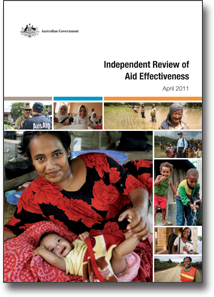Reading through the Independent Review of Aid Effectiveness it is hard not to feel something of a sense of awe: 353 pages of detail on the state of Australian aid coupled with considered advice on how to improve the aid programme. The review is scholarly and sound, and full of information, not just on Australian aid but also contemporary development thought. Many of its recommendations are excellent and most of them are at the very least defensible.
Given all this it feels somewhat churlish to focus a blog post on what I believe the review has gotten wrong. But good policy development requires debate and so, in the spirit of debate, in today’s blog post I am going to take issue with one aspect of the review: its analysis and recommendations regarding AusAID engagement with the private sector (sector F in Chapter 11 – staring on page 224).
My concerns aren’t so much that the section is flat out wrong but rather that it inadequately problematizes what is actually a distinctly difficult area for an aid agency to engage in.
The case made by the review for aid programme engagement with the private sector as a driver of development is a familiar one. Through fostering innovation the private sector contributes to productivity growth, which brings with it rising GDP and raised levels of welfare. Similarly, when set amongst well-functioning institutions and competitive markets private firms, thanks to the magic of invisible hand, contribute to the efficient allocation of resources. If the aid programme can help the private sector in this, it follows that it will be helping improve development outcomes.
This is all true as far as it goes, but it’s only half the story. In addition to contributing to development in the ways outlined in the report, both domestic and international firms have also in many instances delayed or distorted it. From companies that have taken advantage of natural monopolies to price safe drinking water out the reach of the poor to international logging firms that bribe politicians to ignore environmental regulations, private enterprises have done considerable harm in developing countries at times. These negatives don’t mean that the positives don’t also exist — the private sector really does have a lot to offer development. But harnessing this in the weak institutional environment of most developing countries is not necessarily easy, and here the report would be far more convincing if it explicitly acknowledged this.
The report also highlights the potential for corporate social responsibility and inclusive business models to maximise the positive development impacts of private firms, in doing so making the case for more aid support in these areas. Once again this isn’t wrong per se. There is certainly some potential for CSR type work to help improve development outcomes. But there are also risks. In particular, corporate social responsibility can end up being little more than marketing spin designed to improve companies’ images. This isn’t inevitable but the risk is real enough and the report would have been better had it explicitly mentioned it.
Having covered the pros of the private sector the review then outlines AusAID’s current engagement, suggesting that it is inadequate, before making recommendations on how improvements could be made. Four recommendations are made (p 229), one to do with support for corporate social responsibility, the other three all in some way to do with increased AusAID engagement with the private sector.
Development is a complicated endeavour filled with numerous different actors, and it stands to reason that increased engagement is almost always a good thing. So in recommending engagement the review isn’t entirely wrong. But it also neglects the elephant in the room: throughout its history aid has been tarnished by episodes where money ostensibly devoted to helping the poor has been captured by domestic interests in donor countries and effectively used as a subsidy. It’s no mystery why this occurs; the answer is simple political economy. The impacts of aid are felt far away by people who can’t lobby politicians in donor countries. On the other hand the private sector in donor countries can lobby and often does. In a head to head match-up between poor people in faraway lands and powerful political lobbies in donor capital cities the poor don’t often win.
Obviously, the risk posed by domestic business lobbies targeting aid doesn’t mean that AusAID should never engage with Australian firms but it does make increased engagement problematic. And before I’d be comfortable recommending it I would want to hear a lot about just how engagement could be managed in a way that reduces the risk of aid capture. Yet the report doesn’t cover this at all.
Instead, on page 227 the authors of the review concur with a submission from the group Businesses for Millennium Development:
“AusAID’s engagement with business and the private sector has been constrained by a risk–averse attitude within AusAID to engaging with business groups and private sector initiatives.”
As I said at the beginning of this post, the review is an excellent document full of much that is useful and right. But in the case of private sector engagement, if I were advising AusAID I would stress a much more cautious approach.
If the risks are real, there is nothing wrong with being risk averse.
Terence Wood is a PhD student at ANU. Prior to commencing study he worked for the New Zealand government aid programme.






Thanks Jane,
It turns out that we agree on much.
I definitely agree that development is prone to fads, and I’m something of a SWap sceptic (although I do think that the right SWap at the right place at the right time may work well).
My preferred approach for an aid agency working in any particular area would be:
First do the research: find out what the binding constraints on welfare are, study what’s been done in the past, and then carefully choose (from all the available options) an approach most likely to help the poor in the recipient area. I think that before the research is done everything should be on the table in terms of sectors and modalities and so on.
Then run the activity carefully and monitor and evaluate it well.
And then change it if it’s not working.
Where private sector engagement was suggested by preliminary analysis and where evidence suggests it could work, I’d be in favour of it every bit as much as I would an NGO intervention if that’s what context suited.
The one way that I do think the private sector is different from most other development ‘tools’ is in the area of donor country political economy risks. The existence of such risks doesn’t mean that donors should ever engage with home country private sector agents. But – to get back to my original point – let’s make sure we’ve thought carefully about the risks.
Thanks again for your comments
Terence
Hi Terence,
I totally agree with you about minimising risks across the aid program.
I have worked in development for 30 years, more of it in the public sector than the private sector. I have worked for governments, donors, NGOs, volunteer organisations, universities and the private sector. I have a realistic view of the risks inherient in all of these organisations and modes of delivery.
I am a bit tired of the faddism and thought capture that pervades the development industry. The development community threw its self into SWAps, for example, with minimal evidence of their effectiveness in improving development outcomes.
There is often a lack of balance in the development dialogue. One rarely hears discussion of the risks of using NGOs, or universities or multilaterals – and as you are surely aware, there are many.
I encourage you, and indeed AusAID, to look at the evidence, of where and how the private sector can play an effective role in development. The sites I commended to you are a good start, and DFID is commissioning a review of the evidence in relation to mining and PPPs that will be instructive.
I totally agree that there are a wide range of risks in engaging with the private sector – many of these are well documented and need to be managed. But as I said, the private sector is a legitimate player, with a contribution to make. So lets find the evidence and engage with the private sector accordingly.
Making the link to another AusAID initiative related to the private sector – which is the mining sector. I believe that donor engagement with the mining sector and the government in the planning and feasibility stages of mining developments in poor countries in the area of social planning would be incredibly beneficial for example, both to mitigate risk and maximise social benefit.
Hello Jane,
Thank you for your comment. I agree that there are risks throughout the aid programme. And presumably you agree with me that we should try and manage these risks wherever they might occur?
Upon a reread of my paper, you’ll note that my argument above is not that AusAID should never engage with the private sector, or that the private sector has no role to play in development work, but rather that such engagement should be undertaken, cautiously, in a way that minimises those political economy risks associated with subsidising private enterprise with through ODA. (If you’d like evidence – an example of this occurring – look at US Food Aid).
My critique of the aid review (which I think is in many ways and excellent document) is that it doesn’t acknowledge those risks which do exist, nor provide any insights on how to mitigate them. If you have any specific references which detail how aid agencies how engaged with private sector actors from their own country and have done so in a way that has successfully mitigated the risk interest group capture I would be very interested in reading them. Please provide.
Kind regards
Terence
Be cautious with the private sector because there are risks. Of course there are risks! The entire aid program is littered with risks.
Forget the elephant in the room, it’s that old private sector boogeyman again! Just mention the private sector and some of the development set start twitching.
However, lets not just exchange opinions, is there any evidence?
1. The IFC after an extensive study looking at the private sector in health in Africa, made a number of informed recommendations including: Including as many people as possible in risk pooling mechanisms; Channelling a portion of public and donor funds through the private sector; Enacting regulations that are more encouraging of the private sector; Improving access to capital to support private health care enterprises. (IFC “The Business of Health in Africa. Partnering with the private sector to improve people’s lives” IFC, 2008 ).
2. Maybe, take time to look at the website of the Rockefeller Foundation on their initiative “Transforming Health Systems.” Rockefeller have commissioned a number of studies on the role of the private sector in development.
3. Please then move on to the UCSF Global Health Sciences website and look at their publications on the “ Health Systems initiative,” which provide a range of papers on the value of working with the private sector in development.
4. There are countless publications exhorting the importance of the private sector in achieving the MDGs.
5. More locally, the Lowey Institute’s Jenny Hayward Jones contends that private sector engagement is critical in making progress towards MDGs (Hayward-Jones 2008).
I believe that the involvement of the private sector in development initiatives is not a panacea for poverty, but it is a legitimate and valuable asset in the journey towards achieving the Millennium Development Goals. So I congratulate AusAID.
But don’t take my work for it – lets examine the evidence.